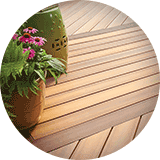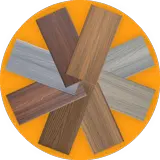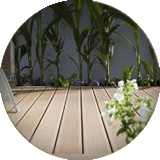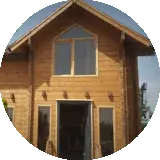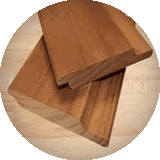natural fiber composites and plastic wood
Excessive deforestation in today’s world is rapidly destroying the habitat of animals and plant species and depleting the planet of oxygen. The situation today is a concern for all of us.
There are solutions to this problem. Innovation and production of a wood substitute made from deciduous waste and recycled polymers.
This new material has the appearance and quality of many rare wood species, while being environmentally friendly.
WPC composites are widely available in Asia today.
Irregular deforestation in today’s world is rapidly destroying the habitats of thousands of plant and animal species and threatening the planet Earth with depletion of oxygen resources.
This study was conducted to investigate the growth trend of the global market of natural fiber and plastic wood composites and also to determine the current position of Iran in this market.
In The Name of God
For NFC natural fiber composites, this study focuses entirely on the automotive sector.
For wpc plastic wood composites, exterior flooring is still the most widely used. But other applications also have a smaller market share.
NFC natural fiber composites in the European automotive industry
Europe has a long history of using plant fibers for a variety of applications. One of these applications is the use of fibers in the automotive sector. In 2005, 19,000 tons of plant fibers (excluding flax wood) were used in the German automotive industry. While this amount in 2000 was 12,000 tons.
Natural fibers in the European automotive industry in 2012 are now listed in the table below.
Composite volume made 2012 tons Natural fiber volume (tons) Fiber type
60,000 30,000 natural fibers
30,000 20,000 fibers
Recycled plants
60,000 30,000 wood fibers
150,000 80,000 total natural fibers
Graph of the use of natural fibers for the manufacture of composites in the European automotive sector in 2012
Reasons for using natural fiber composites in the automotive industry:
Ease of processing
Weight loss up to 30%
_ Competitive price
Good impact behavior (good energy absorption)
Good mechanical and acoustic properties
_ Resistant to flame and slow burning
High share of biological materials
Environmentally friendly and non-toxic
Important applications of natural fibers in the automotive industry:
_ In the car doors
_ Ceiling
_ Dashboard
_ Golgir
_ Floor Covering
_………
Economically, natural fibers are price stable and less dependent on oil prices than other materials. They also use less energy to produce them.
From an environmental point of view:
Reducing CO2 emissions is one of the benefits of using these fibers.
Since natural fiber composites can be used to build lighter vehicles, fuel consumption can be saved. Which is almost twice the standard.
In Europe, targets have been set to reduce CO2 emissions from cars, including a reduction of 130 grams of CO2 per kilometer by 2015 and 95 grams per kilometer by 2020.
The intensity of the use of these wood and natural fibers in the European automotive industry can increase the amount of 30,000 tons per year and each of the natural fibers and wood fibers up to 5 times, which is equivalent to 150,000 tons per year.
WPC plastic wood composites
The total volume of wpc production in Europe in 2012 was 260,000.
Major production in Europe is done by extrusion process to make floor profiles based on PVC and PE. WPCs are also widely used in the production of furniture, technical parts and by using the injection molding and pressing process.
More than 67% of the market is dedicated to flooring using the cholesterol process.
23% of the market is devoted to extruded and molded sheets.
WPC applications in Europe (2012)
Major European countries produce wpc flooring and wall coverings
The largest wpc producers produce more than 10,000 tons of wpc annually.
The total production capacity of wpc in Europe is estimated to be higher than this.
Not only production but also wpc exports in Europe have increased dramatically over the last 7 years, reflecting market demand.
The highest price of wpc in Europe is 170 euros per square meter and the lowest price is 80_40 euros per square meter, which is completely dependent on the quality and type of materials.
Global production and growth rate of wpc between 2010 and 2015 in the world
Global share in 2015 growth rate 2015_2012 in 2015 growth rate 2012_2010 Number of producers in 2012 in 2012 (tons) in 2010 (tons)
- % 35% 7 1,350,000 11% 56 1,100,000 900,000 North America
- % 47% 26 1,800,000 73% 422 900,000 300,000 China
- % 9% 10 350,000 9% 62 260,000 220,000 Europe
- % 3% 19 110.000 27% 25 65.000 40.000 Japan
- % 1% 26 40.000 41% 30 20.000 10.000 Russia
- % 1% 11 55.000 15% 45 40.000 30.000 Southwest Asia
- % 1% 36 50.000 41% 10 20.000 10.000 South America
- % 2% 41 70.000 124% 21 25.000 5.000 India
- % 100% 16 3,825,000 27% 671 2,430,000 1,515,000 total
In Iran, on average, less than 1000 tons of wpc products are produced, which is very small compared to India.

Collection: Dr. Mirbagheri
(Using the contents of the site by mentioning the name of Van Wood is allowed)
Click on the link below to view Van Wood projects
Also, click on the link below to know the price of Plast Van Wood


